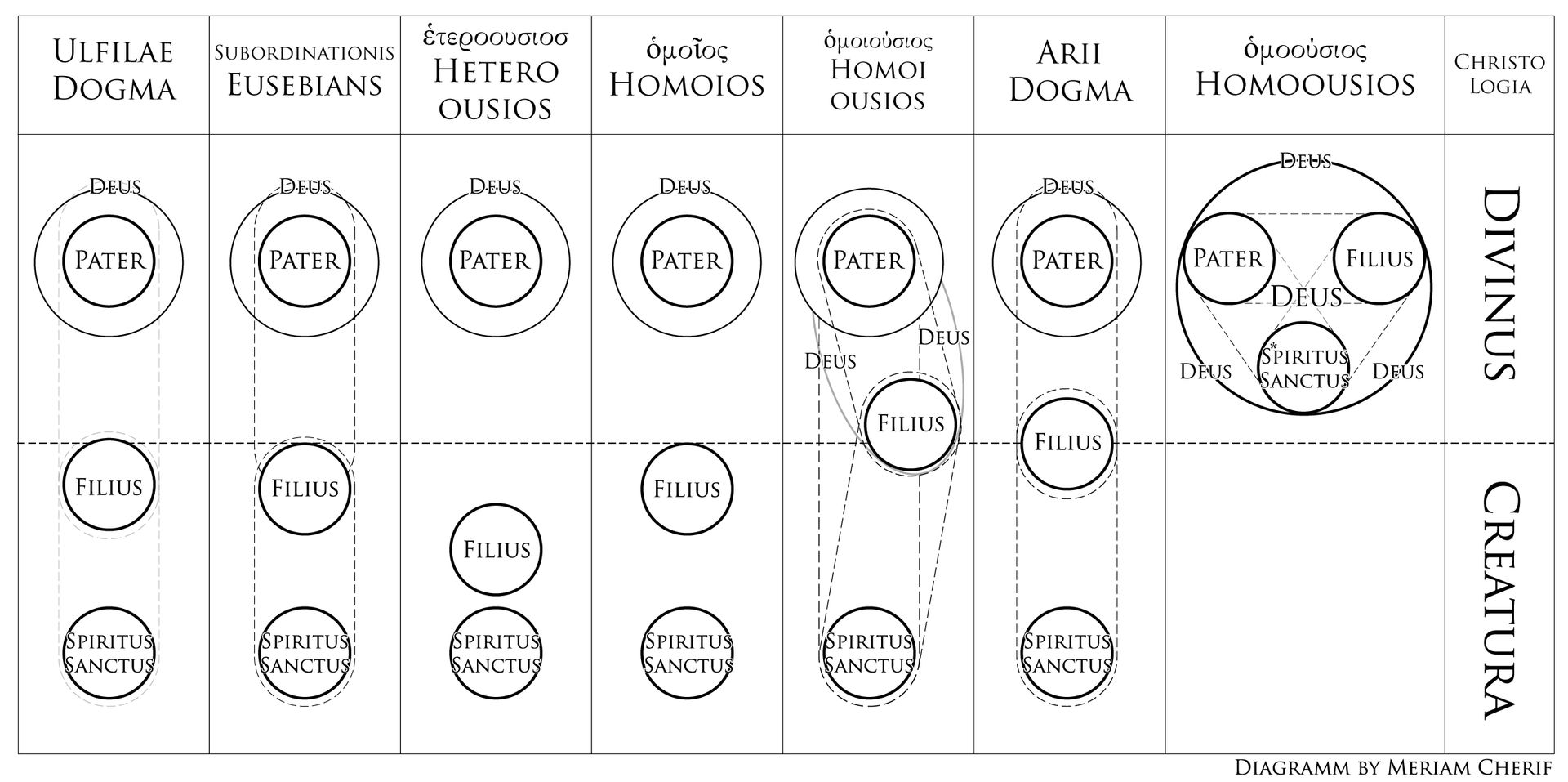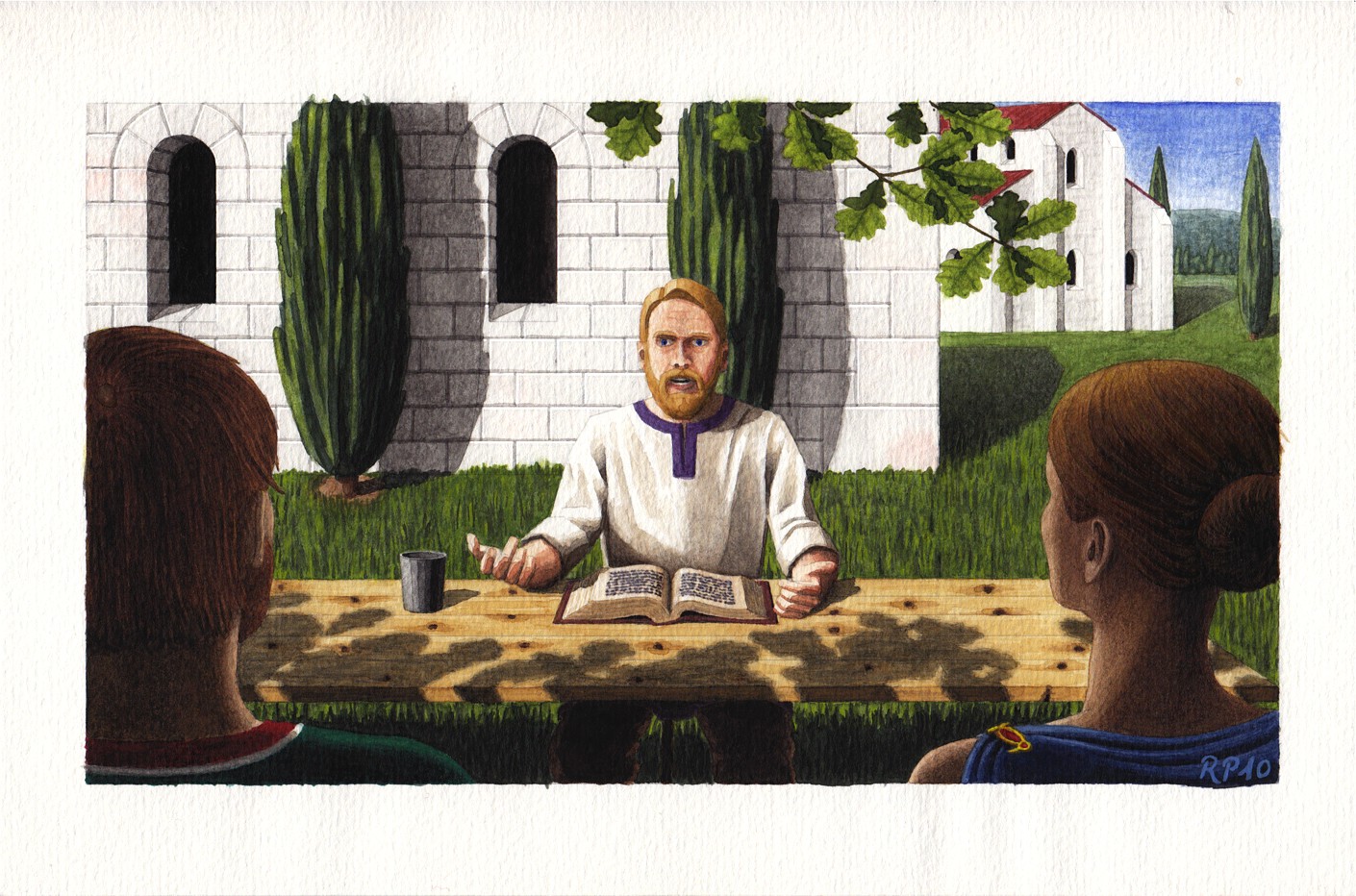For a long time, it was referred to two types of Christians when speaking of the Great Migrations; Catholics on one hand and Arians, sometimes called heretics, on the other. Such statement is not just vague, since the Arians were branches, but even false because the Arians called themselves Catholics as well and it is these so-called Catholics, these Nicenes, who are heretics in their eyes. Understanding the belief of the Vandals seems complicated and requires first the understanding of the headlines of Arianism and its sub-branches.
Arianism
Arianism is a movement that grew out of the dogma of Arius, who did nothing more than underline an already existing, but rather ignored, Christological problem, unless we count Origen, Tertullian or Lucian of Antioch; the nature of the Son and its relation with the Father.
Arius was a Libyan presbyter formed in Alexandria before joining the School of Antioch, under Lucian, from where he developed certain ideas of Unitarianism. After preaching these ideas, that the Son is not a hypostasis of God, that the Father only is God, he was excommunicated by his patriarch Alexander of Alexandria. But having powerful resources and connaissances, such as Eusebius of Nicomedia, Arius returned to the Church while the controversy he created gained more and more ground in the Roman Empire until the Church divided over the question of the nature of the Son and had the Emperor Constantine alarmed at the situation. The Council of Nicaea 325 was held with the Arian controversy as a central issue. Presided over by the emperor himself, and ostensibly by Eusebius of Caesarea, both Arians later, the council aimed to quell the matter, and particularly its main factor Arius.
The Nicene Creed, called Homo-Ousios [Same Essence (the Father and the Son have the same essence)] its adherents are called Homoousians or Nicaeans/Nicenes and it is they who are subjectively, and unfairly to their opponents, called Catholics. This creed was based on a refutation of the non-divinisation of Christ, and there are a number of personalities who took a stand against Arius in this event, only to join him later by developing their own sub-dogmas, of which the most importants are:
- Homoi-Ousios [Likely the same in Essence] Homoiousianism : Sometimes called “Semi-Arianism”. Its followers are called Homoiousians or Semi-Arians.
Among its followers is the Patriarch of Constantinople Macedonius I, founder of Macedonianism, and his followers known as Pneumatomaci. Or George of Laodicea and Meletius I of Antioch. - Homoi-os [Similar in Essence] Homoanism : Sometimes called “Historical Arianism” or “Moderate Arianism”. Its followers are called Homoians.
This dogma says that the natures of the Father and the Son are different but similar without going too deeply into the matter. Their main figure is Acacius, Patriarch of Constantinople, whose dogma is called Acacianism while his followers are called Acacians. They are known to have triumphed in the Councils of Rimini and Seleucia. - Anomoios [Different in Essence] Anomoeanism : Sometimes called “Hetero-Ousios“. Its followers are called Anomoeans or Heteroousians. The followers are mainly those who were banished with Arius at the Council of Nicaea, those who refute any resemblance between the essence of the Father and that of the Son. Among their most important figures are Aetius of Antioch, whose followers are called Aetians, and Eunomius, whose followers are called Eunomians
- Subordinationis / Subordinatianism : Also called Radical Arianism. The roots of this dogma are rather old, and are the same as those of Arius if not more radical. The Arian subordinationists are those who evolved their doctrine by a sort of fusion between Homoiousianism and Anomoeanism and are considered the most radical to the idea that the Son is unquestionably not divine. They include Eusebius of Caesarea and Eusebius of Nicomedia. The followers of the latter are called Eusebians; among them Wulfilas, Constantine the Great and his sons Constantius II and Constantine II.

The conversion of the Vandals
We are not sure where the Vandals got their Christianity from, how they were converted, but they were mostly Christians by the time they left Iberia for Africa. It is most likely that their evangelisation took place when they were close to the Visigoths in two possible locations: Germania and Iberia.
- In Germania, before 406: This theory is based on the claims of Orosius that the Vandals and Suevs (and the Huns too, according to him) who were trying to penetrate the Roman soil believed in God. If the Vandals were Christians before 406, then their evangelisation was at least after 341, when Wulfilas began to preach among the Visigoths, and at most in 378 before the Battle of Adrianople.
- In Iberia, 411: This theory is based on the claims of Salvian of Marseilles, who says that the Vandals were only able to crush the Roman armies at the Pyrenees because the reinforcements they got were biblical verses.
Most historians adhere to the second theory and tend to think that the Vandals converted between 411 and 429.

The question to be asked here is: what kind of Arianism did the Vandals embrace?
We may never claim certainty which dogma they adopted in Iberia, but in Africa we are much sure that they were Homoians. It is possible that they changed their dogma from one sub-Arianism to another in Africa.
The Church of the Vandals
In 427 Count Boniface in Africa had severe problems with Rome, which had to send against him a Goth general, Sigisvult, and with him a priest Maximinus, who took the place of Augustine of Hippo and became the bishop of his city. In the debates between Augustine and Maximinus, one can concludes that the latter was a Homoian and a follower of the Symbol of Rimini and Seleucia. This priest may have given a strong boost to Homoianism in North Africa between 427 and 429 before Sigisvult had to leave. In 429, following Sigisvult’s retreat from Africa, the Vandals were already in Numidia.
Homoianism was very present in Africa at the time of the Vandals’s arrival; the latters were encouraged by the local Homoians and was sawn by them as pious and even “saviours” religiously, while the Nicenes, including the Donatists, called Geiseric a wolf that came to lead the lambs astray. Geiseric is said to be antichrist and his name was interpreted as 666 according to the Donatists. Geiseric empowered the Homoian church against the Nicene one and gradually formed a theocratic state.
Under Huniric, a radical change in the status of the Homoian and Nicene churches took place : Homoianism became orthodoxy and the religion of the state, instituted, while Niceneanism, like all other beliefs, became forbidden in public places and saw its places of worship, churches, closed; it became a sect. Huniric is called the “persecutor king” for this reason; he set fire to the African Nicene church, an act from which the christian community there would never recover even under the French rule.

From what Victor of Vita quoted from Huniric’s words, we could conclude:
- The Vandals were Homoians and took the Synods of Rimini and Seleucia as references.
- The Christian Vandal kings were theocrats par excellence.
- The identity of the Vandal kingdom in Africa, citizenship, was granted by the Homoian church and had as its sole condition a “Homoian baptism“; thus making no distinction between the culture, ethnicity and origin of its subjects.

“Et dum se conflictui paratos adstruverent, primo die a venerabilibus episcopis nostris eis videtur esse propositum, ut omousion, sicut ammoniti erant, ex divinis scripturis proprie adprobarent, aut certe quod a mille et quod excurrit pontificibus de toto orbe in Ariminensi concilio vel apud Seleuciam amputatum est, praedamnarent.” [Victor Vitensis, Historia Persecutionis, III, 5; Petschenig, 1881]
“And when they affirmed that they were prepared for the debate, it is well known that on the first day our venerable bishops proposed to them that they prove the homousion in a proper fashion from the divine Scriptures, just as they had been asked to, failing which they would certainly condemn something which was done away with by a thousand and more bishops from the whole world at the council of Ariminum (Rimini) and at Seleucia” [Translation by John Moorhead, Victor of Vita – History of the Vandal Persecution, 1992]
Anecdotes on the Vandal Church
The Homoian clergy was composed of deacons, priests, presbyters, bishops and called its highest ranking patriarch; we therefore speak of a single patriarch: Patriarch of Carthage.
Bibliographic orientation
Christianism and Vandals
- Mathisen, R. W., 1999, “Sigisvult the Patrician, Maximinus the Arian, and political stratagems in the Western Roman Empire c.425-40“, Early Medieval Europe, 8, 2, 173-196.
- Heather, P., 2003, “Christianity and the Vandals in the Reign of Geiseric“, Bulletin of the Institute of Classical Studies, 50, S91, 137-146.
- Modéran, Y., 2003, “Une guerre de religion: les deux églises d’Afrique à l’époque vandale“, Antiquités Tardives, 11, 21-44.
- Brendt, G. M. and Steinacher, R., 2014, Arianism: Roman Heresy and Barbarian Creed, Farnham.
- Merrills, A. and Miles, R., 2010, “Religion and the Vandal Kingdom“, The Vandals, Chichester.
- Fournier, E., 2012, “Rebaptism as a Ritual of Cultural Integration in Vandal Africa“, Shifting Cultural Frontiers in Late Antiquity.
- Wolff, E., 2015, Littérature, Politique et Religion en Afrique Vandale, Paris.
- Whelan, R., 2018, Being Christian in Vandal Africa: The Politics of Orthodoxy in the Post-Imperial West, Oakland.
Arianism and sub-Arianisms
- Gwatkin, H. M., 1900, Studies of Arianism, Cambridge.
- Leith, J. H., 1963, Creeds of the Churches : A reader in Christian Doctrine from the Bible to the Present, Louisville.
- Aryes, L. 2004, Nicaea and its Legacy : An Approach to the Fourth-Century Trinitarian Theology, Oxford.
- Gwynn, D. M., 2006, The Eusebians: The Polemic of Athanasius of Alexandria and the Construction of the ‘Arian Controversy’, Oxford.

[…] Article in English […]
LikeLike
Reblogged this on MeritAmon Slifer.
LikeLike